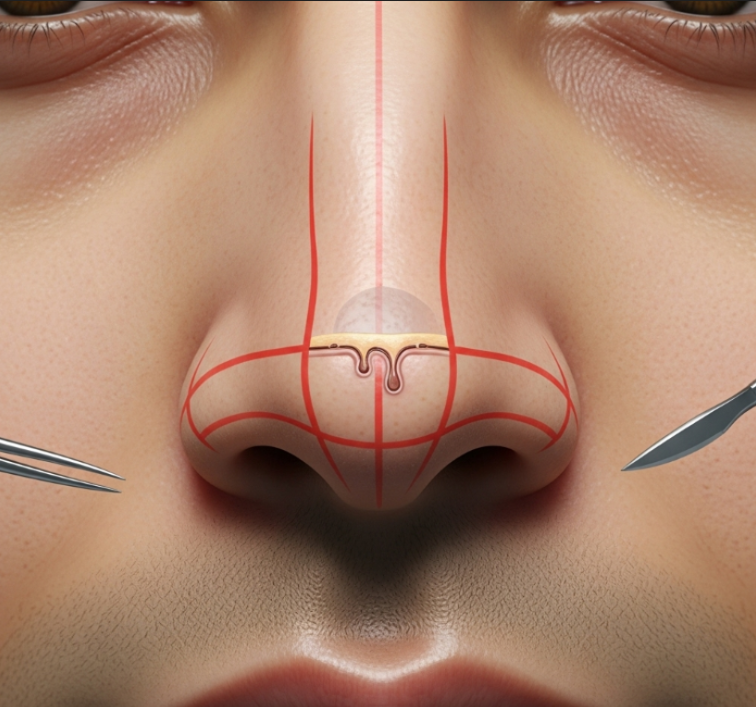Treatment Overview
Bridge Augmentation Closed Rhinoplasty in Korea is a specialized surgical technique used to enhance the height, definition, and contour of the nasal bridge through a closed (scarless) approach. By making incisions only inside the nostrils, Korean surgeons achieve natural results without any visible scars. This method is highly popular among men and women who want a sharper, more refined nasal bridge that harmonizes with their overall facial features.
Purpose & Benefits
- Improves a low or flat nasal bridge, common in Asian and ethnic patients.
- Enhances facial balance by refining the nose-to-forehead ratio.
- Provides natural height and definition to the nose.
- Minimizes surgical trauma with no external incisions.
- Shorter recovery time compared to open bridge augmentation.
- Ideal for patients seeking a discreet yet noticeable enhancement.
Ideal Candidates
- Individuals with a naturally low, flat, or wide nasal bridge.
- Patients seeking scarless augmentation through closed rhinoplasty.
- Those who prefer a shorter downtime and minimal visible signs of surgery.
- Men and women wanting to enhance the bridge while maintaining natural balance.
- Patients looking for primary augmentation or minor revision work.
Possible Risks & Complications
- Temporary swelling and mild bruising.
- Implant shifting or irregular contour (rare in expert hands).
- Infection or implant rejection (extremely rare).
- Minor asymmetry in nasal height or width.
- Potential need for revision surgery if results are unsatisfactory.
Surgical Techniques Used
- Closed Internal Incision: Performed inside the nostrils for scarless results.
- Bridge Implant or Cartilage Placement: Using silicone, Gore-Tex, or autologous cartilage.
- Precision Shaping: Ensures smooth, symmetrical nasal bridge enhancement.
- Combined Approach: Can be paired with tip refinement, dorsal augmentation, or alar adjustments.
- Advanced Korean Techniques: Ultra-thin implants or custom 3D-designed grafts for natural outcomes.
Recovery & Aftercare
- Downtime: 7–10 days for initial swelling to subside.
- Bruising: Minimal due to closed incision method.
- Stitches: Dissolvable internal sutures.
- Aftercare in Korea includes:
- Swelling-reduction therapies (ultrasound, laser)
- Post-surgical care kits and regular follow-ups
- Scarless healing management
- Multilingual support for international patients
Results & Longevity
- Provides a sharper, more elevated nasal bridge.
- Natural-looking results that complement the forehead and nasal tip.
- Long-lasting enhancement (10+ years for implants, permanent with cartilage grafts).
- Stable bridge contour with proper healing and care.
Treatment Process in Korea
- Consultation & 3D Imaging: Personalized analysis of nose shape and desired bridge height.
- Customized Surgical Plan: Selection of implant type (silicone, Gore-Tex, or cartilage).
- Scarless Closed Procedure: No external incisions, reduced swelling, and quicker recovery.
- Combination with Other Techniques: Often paired with tip plasty or alar base refinement for balanced results.
- Why Korea is Best: Korean surgeons are world-renowned for precise bridge augmentation that looks natural and elegant. Clinics also use custom implants, cartilage grafting, and advanced scarless techniques, making Korea a global leader in rhinoplasty.
Cost Range
The price of Bridge Augmentation Closed Rhinoplasty in Korea depends on implant material and complexity:
- Basic closed bridge augmentation (implant): ₩4,000,000 – ₩6,000,000 KRW ($3,000 – $4,600 USD)
- Bridge augmentation with cartilage grafting: ₩6,500,000 – ₩8,500,000 KRW ($5,000 – $6,600 USD)
- Complex/revision closed augmentation cases: ₩9,000,000 – ₩12,000,000 KRW ($6,900 – $9,200 USD)
Most clinics include:
- Surgeon’s fee and anesthesia
- Hospital and operating costs
- Post-op follow-ups and swelling management treatments
- English/Chinese interpretation services for foreigners
Popular Clinics in Korea
- ID Hospital (Seoul): Leader in scarless closed rhinoplasty and bridge augmentation.
- Banobagi Plastic Surgery (Seoul): Known for balanced, natural bridge enhancement.
- JW Plastic Surgery (Seoul): Offers advanced closed techniques with implant-cartilage hybrid options.
- View Plastic Surgery (Seoul): Famous for natural profile correction and bridge contouring.
- The PLUS Plastic Surgery (Seoul): Preferred by international patients for refined, scarless results.




